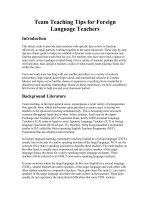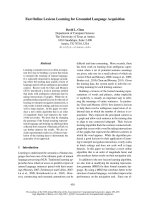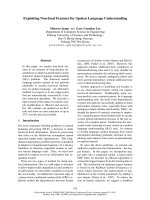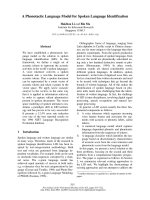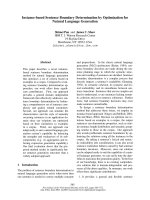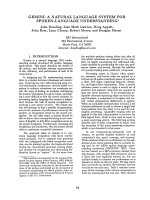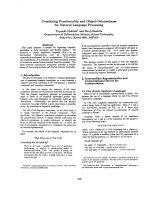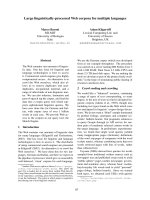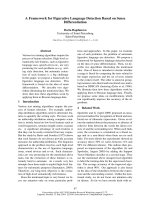Stands for Procedural Language
Bạn đang xem bản rút gọn của tài liệu. Xem và tải ngay bản đầy đủ của tài liệu tại đây (212.49 KB, 68 trang )
PL/SQL
Objectives
Objectives
Why PL-SQL ?
Why PL-SQL ?
Language features
Language features
Basic Structure of PL/SQL program
Basic Structure of PL/SQL program
Data Types
Data Types
Control Flow in PL-SQL
Control Flow in PL-SQL
Loops in PL-SQL
Loops in PL-SQL
Why PL SQL ?
Why PL SQL ?
PL/SQL stands for Procedural Language/SQL.
PL/SQL stands for Procedural Language/SQL.
PL/SQL extends SQL by adding constructs found in
PL/SQL extends SQL by adding constructs found in
procedural languages like procedures, loops, variables,
procedural languages like procedures, loops, variables,
objects etc.
objects etc.
Resulting a structural language that is more powerful
Resulting a structural language that is more powerful
than SQL
than SQL
PL SQL, Is there any Advantage ?
PL SQL, Is there any Advantage ?
In case of SQL to send 3 queries we will need three
In case of SQL to send 3 queries we will need three
network trips between client and server.
network trips between client and server.
In PL-SQL we bundle any number of queries in a block
In PL-SQL we bundle any number of queries in a block
and in single network trip task is done.
and in single network trip task is done.
SQL
Query1
SQL
Query2
SQL
Query3
Client
Server
SQL
Query1
SQL
Query2
SQL
Query3
Client
Server
PL-SQL Block
Language features
Language features
Supports constructs like any other 4th generation
Supports constructs like any other 4th generation
language:
language:
Variables and Data types
Variables and Data types
Loops and Control statements
Loops and Control statements
Procedures and Functions
Procedures and Functions
Packages
Packages
Triggers
Triggers
Objects
Objects
Records (Its like structure in C language)
Records (Its like structure in C language)
PL SQL program structure
PL SQL program structure
Declare
Declare
<All Variables, cursors, exception etc are declared here>
<All Variables, cursors, exception etc are declared here>
Begin
Begin
<All programming logic , queries , program statements are written
<All programming logic , queries , program statements are written
here>
here>
Exception
Exception
<All Error Handling code is written here>
<All Error Handling code is written here>
End;
End;
It ends the program
It ends the program
PL SQL nested block
PL SQL nested block
<<Outer Block>>
<<Outer Block>>
Declare
Declare
Begin
Begin
<<Inner Block>>
<<Inner Block>>
Declare
Declare
Begin
Begin
Exception
Exception
End;
End;
Exception
Exception
End;
End;
PL SQL Block
PL SQL Block
Remember :
Remember :
Declare is optional and only required when variables need to be declared.
Declare is optional and only required when variables need to be declared.
Exception is optional and required when Error/Exception handling is done.
Exception is optional and required when Error/Exception handling is done.
Begin and End are mandatory as all logic and queries are written inside it.
Begin and End are mandatory as all logic and queries are written inside it.
Declare
Declare
Begin
Begin
Exception
Exception
End;
End;
PL SQL program- Sample I
PL SQL program- Sample I
BEGIN
BEGIN
Insert into Dept values(70,’HR’,’Pune’);
Insert into Dept values(70,’HR’,’Pune’);
Insert into Dept values(80,’PSD’,’Mumbai’);
Insert into Dept values(80,’PSD’,’Mumbai’);
Insert into Dept values(90,’ESG’,’Pune’);
Insert into Dept values(90,’ESG’,’Pune’);
END;
END;
This program will insert three records at the same time in the table dept.
This program will insert three records at the same time in the table dept.
PL SQL program- Sample II
PL SQL program- Sample II
This program displays the sum of two numbers
This program displays the sum of two numbers
DECLARE
DECLARE
v_num1 Number;
v_num1 Number;
v_num2 Number;
v_num2 Number;
v_sum Number;
v_sum Number;
BEGIN
BEGIN
V_num1 := &Number1;
V_num1 := &Number1;
V_num2 := &Number2;
V_num2 := &Number2;
V_sum := v_num1 + v_num2 ;
V_sum := v_num1 + v_num2 ;
Dbms_Output.Put_Line (‘The Sum of number is :’ || v_sum);
Dbms_Output.Put_Line (‘The Sum of number is :’ || v_sum);
END;
END;
Save , Edit and Execute program
Save , Edit and Execute program
Type your program in SQL * plus
Type your program in SQL * plus
To save :
To save :
Save <File Name>
Save <File Name>
Program is saved in the bin directory to save in other folder give complete path.
Program is saved in the bin directory to save in other folder give complete path.
Eg:
Eg:
Save ‘C:\ESG\FirstPrg.sql’
Save ‘C:\ESG\FirstPrg.sql’
To make changes:
To make changes:
Edit <File Name>
Edit <File Name>
To edit program saved in folder other then bin
To edit program saved in folder other then bin
Edit ‘C:\ESG\FirstPrg.Sql’
Edit ‘C:\ESG\FirstPrg.Sql’
To Execute:
To Execute:
@ File Name
@ File Name
To execute program saved in folder other then bin.
To execute program saved in folder other then bin.
@ ‘C:\ESG\FirstPrg.Sql’
@ ‘C:\ESG\FirstPrg.Sql’
Important Keywords
Important Keywords
Following are the keywords in PL-SQL , should not be used as a
Following are the keywords in PL-SQL , should not be used as a
variable name.
variable name.
DECLARE
DECLARE
BEGIN
BEGIN
END
END
EXCEPTION
EXCEPTION
LOOP , END LOOP
LOOP , END LOOP
IF , ELSE , ELSIF , END IF
IF , ELSE , ELSIF , END IF
CURSOR
CURSOR
PROCEDURE
PROCEDURE
FUNCTION
FUNCTION
Cont
Cont
Important Keywords
Important Keywords
Keywords
Keywords
PACKAGE
PACKAGE
TRIGGER
TRIGGER
GRANT
GRANT
REVOKE
REVOKE
FOR
FOR
WHILE
WHILE
CASE
CASE
VARRAY
VARRAY
TYPE
TYPE
OBJECT
OBJECT
Operators
Operators
Important operators in PL SQL
Important operators in PL SQL
Airthmetic :
Airthmetic :
( + , - , * , /)
( + , - , * , /)
Logical: (AND , OR , NOT)
Logical: (AND , OR , NOT)
Comparison:
Comparison:
(<=, <, >, =)
(<=, <, >, =)
Comments (Two hyphens):
Comments (Two hyphens):
Assignment operator: In PL SQL assignment operator is
Assignment operator: In PL SQL assignment operator is
:=
:=
So to assign values we need to write :=
So to assign values we need to write :=
Examples:
Examples:
z := x + y
z := x + y
z := x
z := x
z := 100
z := 100
name := ‘MBT’
name := ‘MBT’
Operators
Operators
Important operators in PL SQL
Important operators in PL SQL
Line ends with operator
Line ends with operator
:
:
;
;
To join two strings:
To join two strings:
||
||
To accept value:
To accept value:
&
&
Power
Power
**
**
2**3 means 2 raise to power 3
2**3 means 2 raise to power 3
In loop we use
In loop we use
Example:
Example:
For X in 1 5 means
For X in 1 5 means
1 to 5
1 to 5
Non numeric data
Non numeric data
(string or date)
(string or date)
is written in single
is written in single
quote:
quote:
‘ ‘
‘ ‘
Accept a value
Accept a value
Examples:
Examples:
num1 := &Number1;
num1 := &Number1;
At run time this will prompt as
At run time this will prompt as
Follows
Follows
Whatever value user will enter
Whatever value user will enter
here will be assign to variable
here will be assign to variable
num1
num1
Enter a value for Number1:
Enter a value for Number1:
Accept a value
Accept a value
Examples:
Examples:
name := ‘&Name’;
name := ‘&Name’;
At run time this will prompt as
At run time this will prompt as
Follows
Follows
Whatever value user will enter
Whatever value user will enter
here will be assign to variable
here will be assign to variable
name
name
‘ ‘
‘ ‘
is used in case if entered data is not numeric
is used in case if entered data is not numeric
Enter a value for Name:
Enter a value for Name:
Display value
Display value
To display on same line:
To display on same line:
dbms_output.put()
dbms_output.put()
To display on new line.
To display on new line.
dbms_output.put_line()
dbms_output.put_line()
Here dbms_output is a Oracle package its like header file or library
Here dbms_output is a Oracle package its like header file or library
in C language.
in C language.
.Put and .Put_Line are functions like printf in ‘C’ language
.Put and .Put_Line are functions like printf in ‘C’ language
Display value : Examples
Display value : Examples
Dbms_output.put (‘Mahindra’);
Dbms_output.put (‘Mahindra’);
Dbms_output.put (‘British’);
Dbms_output.put (‘British’);
Dbms_output.put (‘Telecom’);
Dbms_output.put (‘Telecom’);
Dbms_output.put_line(‘ ‘);
Dbms_output.put_line(‘ ‘);
It will display
It will display
Mahindra British Telecom
Mahindra British Telecom
on same line.
on same line.
Note :
Note :
1.
1.
On SQL prompt after Login you need to set one command to see displayed values.
On SQL prompt after Login you need to set one command to see displayed values.
SET SERVEROUTPUT ON
SET SERVEROUTPUT ON
2.
2.
It is important that at least once you write .put_line after any number of .put functions
It is important that at least once you write .put_line after any number of .put functions
else values are not displayed.
else values are not displayed.
Display value : Examples
Display value : Examples
Dbms_output.put_line (‘Mahindra’);
Dbms_output.put_line (‘Mahindra’);
Dbms_output.put_line (‘British’);
Dbms_output.put_line (‘British’);
Dbms_output.put_line (‘Telecom’);
Dbms_output.put_line (‘Telecom’);
It will display
It will display
Mahindra
Mahindra
British
British
Telecom
Telecom
on different lines.
on different lines.
Note :
Note :
1.
1.
On SQL prompt after Login you need to set one command to see displayed values.
On SQL prompt after Login you need to set one command to see displayed values.
SET SERVEROUTPUT ON
SET SERVEROUTPUT ON
DML operations in Pl-SQL
DML operations in Pl-SQL
All DML operations (Insert/Update/Delete /Select) are to be written in
All DML operations (Insert/Update/Delete /Select) are to be written in
Begin part of the block.
Begin part of the block.
No change in the Syntax of Insert , Update and Delete , it is same as
No change in the Syntax of Insert , Update and Delete , it is same as
SQL.
SQL.
Select syntax is different then SQL , it contains INTO clause.
Select syntax is different then SQL , it contains INTO clause.
If Select query can return more then one rows then you should
If Select query can return more then one rows then you should
always use cursors .
always use cursors .
Select Syntax for a Single Row
Select Syntax for a Single Row
Query.
Query.
Select column1, column2
Select column1, column2
INTO Variable1,Variable2
INTO Variable1,Variable2
From Table Name
From Table Name
Where condition …
Where condition …
The only change is as many columns you want to get from the
The only change is as many columns you want to get from the
query you need to declare that many variables and use INTO
query you need to declare that many variables and use INTO
clause.
clause.
All other parts of query are unchanged
All other parts of query are unchanged
If Where condition here is such that query will return multiple
If Where condition here is such that query will return multiple
records then CURSOR should be used. Without that it will give
records then CURSOR should be used. Without that it will give
error.
error.
Data Types in PL SQL
Data Types in PL SQL
Scalar Types
Scalar Types
Char
Char
CHAR datatype to store fixed-length character data.
CHAR datatype to store fixed-length character data.
Maximum size =
Maximum size =
2000 bytes
2000 bytes
Varchar2
Varchar2
VARCHAR2 datatype to store variable-length character
VARCHAR2 datatype to store variable-length character
.
.
Maximum size =
Maximum size =
4000 bytes
4000 bytes
Number
Number
Number types let you store numeric data (integers, real numbers, and
Number types let you store numeric data (integers, real numbers, and
floating-point numbers), represent quantities, and do calculations.
floating-point numbers), represent quantities, and do calculations.
Data Types in PL SQL
Data Types in PL SQL
Scalar Types
Scalar Types
Binary_Integer
Binary_Integer
The BINARY_INTEGER datatype to store signed integers (-
The BINARY_INTEGER datatype to store signed integers (-
2**31 to 2**31)
2**31 to 2**31)
Date
Date
DATE datatype to store fixed-length datetimes
DATE datatype to store fixed-length datetimes
Long
Long
The LONG datatype to store variable-length character strings.
The LONG datatype to store variable-length character strings.
The LONG datatype is like the VARCHAR2 datatype, except that
The LONG datatype is like the VARCHAR2 datatype, except that
the maximum size of a LONG value is 32760 bytes.
the maximum size of a LONG value is 32760 bytes.
Data Types in PL SQL
Data Types in PL SQL
Scalar Types
Scalar Types
NChar
NChar
To store multi byte fixed length character data. Its same as Char
To store multi byte fixed length character data. Its same as Char
only difference is it is used to store characters of different
only difference is it is used to store characters of different
language like Japenese , chinese etc.
language like Japenese , chinese etc.
Number of characters it can store depend on language.
Number of characters it can store depend on language.
NVarchar
NVarchar
To store multi byte variable length character data. Its same as
To store multi byte variable length character data. Its same as
Varchar2 only difference is it is used to store characters of
Varchar2 only difference is it is used to store characters of
different language like Japenese , chinese etc.
different language like Japenese , chinese etc.
Number of characters it can store depend on language.
Number of characters it can store depend on language.
